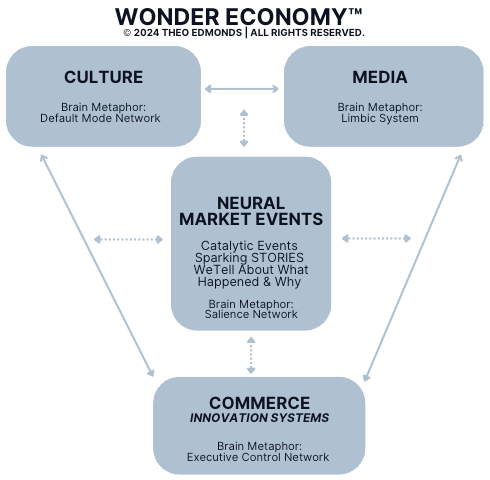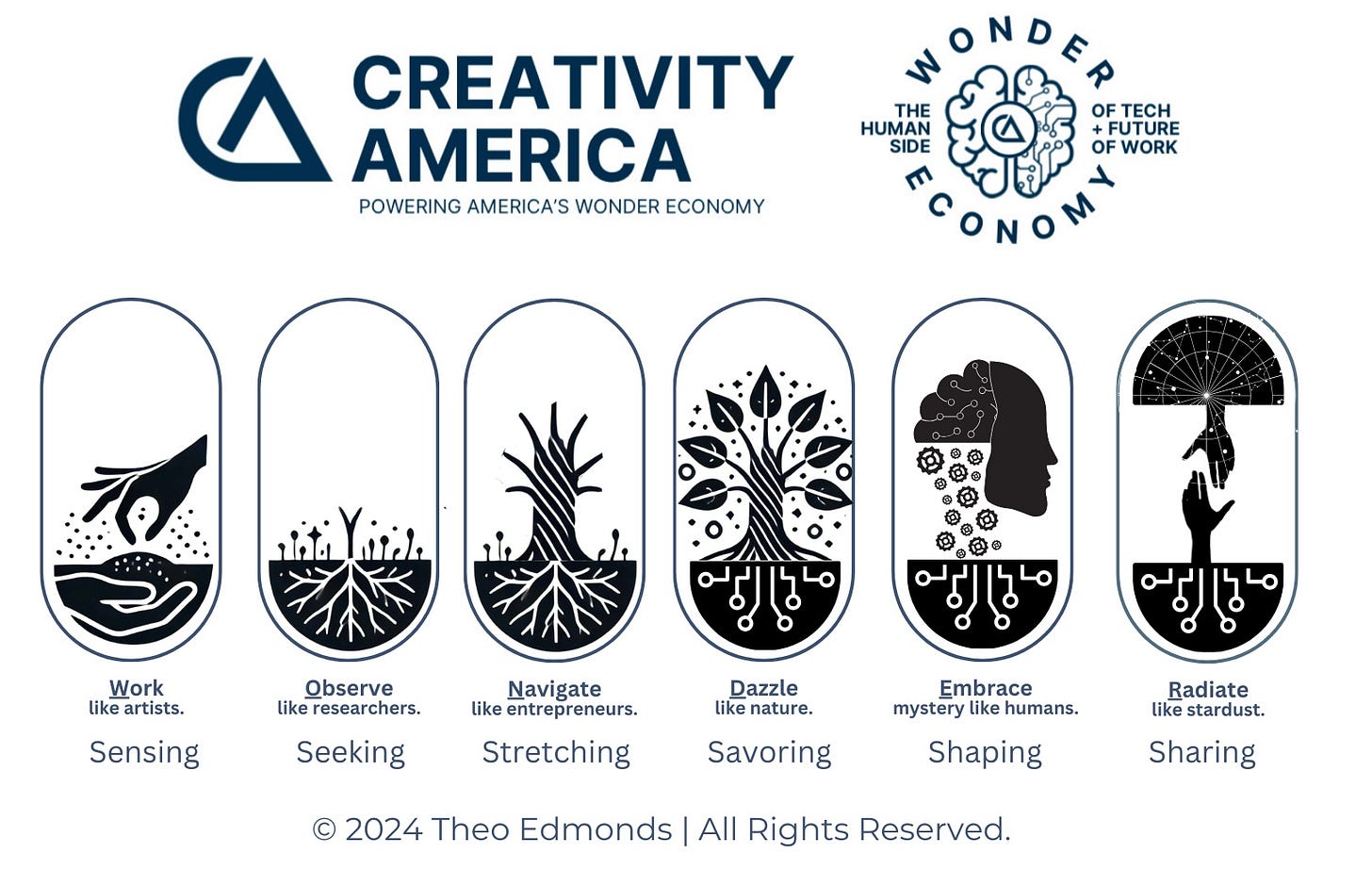Our Big American Dreams
How Sleep, Brain Science, AI & Tricksters Are Shaping What’s Next for American Enterprise
Dream Chasers
Do I dare disturb the universe? – T.S. Eliot
What does it mean to "chase a dream"? For centuries, entrepreneurs and innovators have used dreams—both literal and metaphorical—as tools for creativity. Today, we even see scientists using dream-like hallucinations by artificial intelligence to improve creativity in science.
Dreams hold something we recognize as a map for navigating the spaces between what we know through experience and what we experience as the unknown. As Langston Hughes wrote, “Hold fast to dreams, for if dreams die, life is a broken-winged bird that cannot fly.” Thoreau described our “truest life” as when we are “in dreams awake.”
Thomas Edison famously napped with steel balls in his hands, letting them fall as he drifted into hypnagogia, the liminal state between wakefulness and sleep. Salvador Dalí called this moment his portal to the surreal, a space where little pieces of the day fuse into new ideas. These fleeting states, hovering just outside consciousness, invite us to explore beyond what we know.
While the hypnagogic state—the transition into sleep—has been widely recognized for its role in fostering creativity, the hypnopompic state, which occurs as we awaken, also offers unique opportunities for insight. This transitional phase allows the mind to blend dream fragments with waking reality, facilitating new connections.
This weekend, I’ve been reflecting on the passing of filmmaker David Lynch, whose work often seems to mirror the hypnopompic state—a surreal bridge between dreaming and waking. His films evoke the hazy, fragmented logic of the hypnopompic mind, where the subconscious seeps into waking reality, blending the ordinary with the extraordinary. Lynch’s ability to evoke this state through storytelling reminds us of the profound insights hidden in transitions.
Julia Cameron’s morning writing technique, introduced nearly forty years ago in The Artist’s Way, offers another tool to access this power. She taught how capturing hypnopompic dream fragments upon waking can turn subconscious material into creative solutions.
Our ability to dream supports problem-solving in our waking lives across the arts, sciences, and business. But why? To answer that, we must explore the neuroscience of sleep and the brain’s creative networks.
The Neuroscience of Sleep and Creativity
"The future enters into us, in order to transform itself in us, long before it happens." – Rainer Maria Rilke
Sleep isn’t just rest; it’s where creativity takes root. The brain, freed from the noise of waking life, turns inward to weave connections, process emotions, and prepare for action. Sleep cycles through four stages—awake, core, REM, and deep—each playing a specific role in shaping creativity:
REM Sleep and the Default Mode Network (DMN): During REM, the DMN becomes a playground for divergent thinking. This is where ideas are born, where fragments of thought collide and spark into new possibilities.
Deep Sleep and the Executive Control Network (ECN): While the ECN goes offline during sleep, Deep Sleep recharges its circuits. By morning, it’s ready to help sift through ideas, turning chaos into clarity.
Core Sleep and the Salience Network: Core Sleep (light sleep) engages the Salience Network, which filters sensory input and determines what matters most. This stage prepares the brain for focus and prioritization.
The Limbic System: Active in REM and Core Sleep, the Limbic System infuses emotional depth into memories and ideas, giving creativity its human resonance.
Together, these networks form a nocturnal journey, blending imagination, focus, and emotion. Sleep doesn’t simply recharge us—it equips us to connect ideas, find meaning, and take action.
Using Sleep as a Creative Tool
I’m constantly seeking hacks to boost my creativity. Recently, I began monitoring my sleep patterns with my Apple Watch to understand how they influence my creativity throughout the day. Here’s a glimpse into what I discovered from one night’s data:
REM Sleep (2 hrs, 12 min / 23%): My creative incubator. The DMN and Limbic System combine to synthesize emotions and spark imaginative leaps.
Core Sleep (4 hrs, 49 min / 61%): Mental organization. Driven by the Salience Network, this phase bridges abstract ideas with structured problem-solving.
Deep Sleep (48 min / 10%): Though below average for the “optimal” range researchers say is preferred, my deep sleep signals show that my body was active in strengthening its neural connections, clearing mental "clutter" to leave me refreshed enough to act on creative ideas.
Dreams amplify the collaboration among these networks. Like salience events—moments that grab your attention and feel important—dreams filter and prioritize insights, often framing decisions or actions in unexpected ways.
Our American Dream Cycle
"A dreamer is one who can only find his way by moonlight, and his punishment is that he sees the dawn before the rest of the world." – Oscar Wilde
As our nation observes the passing of power between presidents and honors the life and legacy of Dr. Martin Luther King Jr. on the same day, my thoughts turn to the current state of the American Dream. What does it mean to collectively dream as a society in moments like this?
A dream is not a static moment set in stone. It is an evergreen journey, continually pushing us beyond the old frontiers of what we think we know. Societies, like individuals, experience transitions between dormancy and awakening—moments of inertia followed by bursts of transformation. These shifts mirror the brain’s hypnagogic and hypnopompic states.
Hypnagogic Societies: When societies drift into passive complacency, distracted by comfort or spectacle, they reflect the hypnagogic state. For instance, Ancient Rome’s coliseum, where entertainment and overconfidence masked deeper systemic issues.
Hypnopompic Societies: Disruptive events stir societies from dormancy, much like the transition from sleep to wakefulness during the hypnopompic state. These moments force a shift in perspective, where remnants of the past mingle with new realities. For example, the fall of the Berlin Wall was a hypnopompic moment—a time when new paradigms emerged from the convergence of disruption and awareness.
We've seen this, too, in our American Dream. Pivotal events like technological revolutions and cultural movements act as salience events—a shift triggered by disruption that forces systems to refocus attention and energy.
The Civil Rights Movement of the 1950s and 1960s was a hypnopompic moment for America. It was a collective awakening to the systemic realities of unequal opportunity.
The technological revolution of the 1990s offered another awakening, revealing technology's potential to transform personal and professional lives.
These moments reshaped America’s priorities, challenging the status quo and laying the groundwork for new possibilities. Today, we seem to be standing at another frontier moment of some kind. The question I can’t seem to shake or fully answer is: Are we drifting into complacency, or are we waking up to imagine and create something entirely new?
Neural Market Events and the Wonder Economy™
The convergence of our national leadership transition and Dr. King’s enduring legacy highlights our nation’s potential for reshaping its future through collaborative creativity.
This process isn’t random. Like our brains, societies cycle through distinct states of creativity, following specific data signals and culture patterns that point to an approaching moment of transformation. Still, you have to know where to look. Because they reshape America’s collective Creative Brain Capital™, I have coined these pivotal transformation moments as Neural Market Events (NMEs).
Like the brain’s Salience Network, NMEs simultaneously create new action frames across the three pillars of American innovation: culture, commerce, and media.
Culture (Default Mode Network): America’s “dream space,” generating foundational ideas and values.
Commerce (Executive Control Network): Organizes creativity into actionable systems.
Media (Limbic System): Connects people through shared narratives and emotions.
NMEs fall into three categories:
Predictable NMEs, such as presidential elections, are scheduled events with uncertain outcomes, allowing for preemptive action based on observable patterns.
Foreseeable NMEs, like the launch of the iPhone and the COVID-19 pandemic, emerge from trends visible to those tracking them. They require rapid adaptation and readiness.
Mega NMEs evolve over generations and build like a type of culture kudzu that overwhelms societal systems until, ultimately, a systemic reset is induced.
Collectively, I call this the Wonder Economy™ because wonder, as an epistemic emotion, plays a central role in motivating humans to explore new frontiers. This is an essential feature across all aspects of the American enterprise: arts, science, business, and technology.
America’s New Age of Wonder
The Wonder Economy™ thrives on cycles of creativity, collaboration, and innovation. Yet, as with any transformative system, disruption is inevitable—and often essential.
One of my favorite books is Lewis Hyde’s Trickster Makes the World. In this magical little book, Hyde explores how, throughout human history, the trickster archetype has acted as a force that “disrupts the accepted order to loosen the soil and let something new take root.” These figures—equal parts chaos and creativity—appear across cultures, from Loki in Norse mythology to Anansi in West African folklore and Shakespeare’s Puck in Midsummer Night’s Dream; the trickster blends mischief with a knack for setting the world right again.
In 2025, I see human creativity and artificial intelligence coming together as a type of modern trickster, disrupting and reshaping culture, commerce, and media. While our brains offer a compelling map for using our cognitive creativity to navigate forward, our success will depend on shoring up our emotional and social creativity to move forward in a way that fosters collaboration over division.
WONDERvation
From biometric wearables like the Apple Watch to neuroscience labs, innovation hubs, and artist studios, we all exist within interconnected systems and trends that influence what we perceive as possible and valuable. Understanding and navigating these intersections forms the core of my work as a Culture Futurist®.
Creativity is a cycle of dreaming, organizing, acting, and growing—though this last part is a choice we must make, not a foregone conclusion.
I founded Creativity America to make collaborative dreaming a reality again through a six-step process I call Wondervation™.
Work Like Artists: Use courageous imagination to break boundaries.
Observe Like Researchers: Synthesize data to ground ideas in evidence.
Navigate Like Entrepreneurs: Adapt and iterate with agility.
Dazzle Like Nature: Blend aesthetics, ingenuity, and sustainability.
Embrace Mystery Like Humans: Explore ambiguity to uncover breakthroughs.
Radiate Like Stardust: Amplify success through storytelling and networks.
Wondervation™ uses the art and science of creativity to transform imagination into innovation. The process aligns human motivation for discovery with strategy and foresight, empowering leaders to adopt Creative Brain Capital™ as key performance indicator for cultural and economic growth.
I understand the skepticism some may have regarding this. It’s natural to cling to what is familiar in uncertain times. Yet, history reveals a profound truth: when we engage in wonder, dare to dream, and explore beyond old frontiers, we often discover something even more meaningful.
Our big American Dream is in transition again. Connecting creative strategy with culture foresight matters. Being able to co-create what’s next, together, matters even more. As I fall asleep tonight, I’ll enter through a meditation of gratitude—not grievance—for being an American in 2025. I’ll contemplate what our nation’s 250th Anniversary in 2026 might bring. And, in the words of the trickster, John Lennon, I’ll find joy in knowing that some “…may say I'm a dreamer, but I'm not the only one."
BONUS CONTENT 👉✨ Are you a poetry lover? Then you might want to check out my companion poem to this article— Wilderness Skills.
Theo Edmonds, Culture Futurist® & Founder, Creativity America | Bridging Creative Industries and Brain Science with Future of Work & Wondervation®
© 2024 Theo Edmonds | All Rights Reserved. This article contains proprietary intellectual property. Any reproduction, distribution, or adaptation, in whole or in part, is prohibited without explicit written permission from the author. Please attribute content accurately when referenced or shared. The views expressed herein are those of the author and do not necessarily represent those of any affiliated organization or institution.








